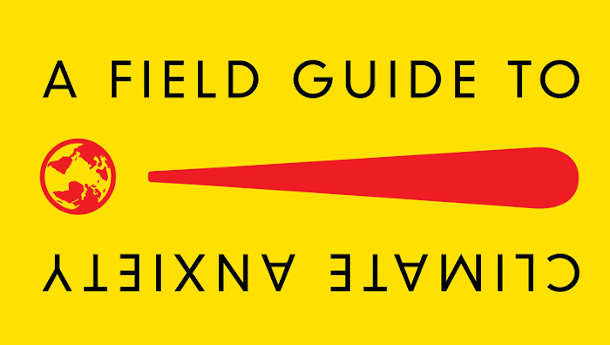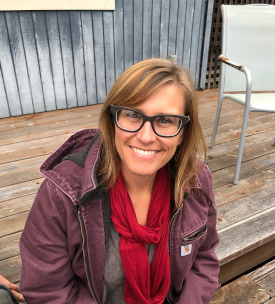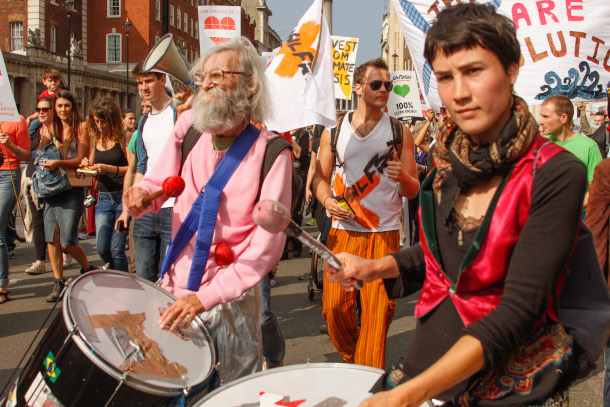Overcoming Climate Anxiety
Air Date: Week of October 23, 2020

A Field Guide to Climate Anxiety helps provide readers with an ‘existential toolkit’ for confronting the climate crisis. (Image: Courtesy of Sarah Jaquette Ray)
Climate change is disrupting lives and causing deep anxiety, especially for the young people organizing to address it. The new book A Field Guide to Climate Anxiety: How to Keep Your Cool on a Warming Planet lays out strategies for addressing climate-fueled anxieties and moving beyond them to help Gen Z activists envision a resilient future. Author Sarah Jaquette Ray joined Living on Earth’s Jenni Doering for a virtual live event to discuss the importance of equipping young activists with the emotional tools they need to bring about change.
Transcript
BASCOMB: From melting glaciers and sea level rise to tropical deforestation and habitat loss the many problems associated with climate disruption can feel overwhelming and, frankly depressing. And people are already feeling the impacts of climate change that will be with us for the rest of our lives. With such a burdensome future many young people are organizing for climate action, yet it can be hard to deal with the feelings of powerlessness and despair that can accompany the hard work of social movements. So, for some cheer they might want to read a new book called A Field Guide to Climate Anxiety: How To Keep Your Cool on a Warming Planet. Its author is Sarah Jaquette Ray, professor of environmental studies at Humboldt State University in California. In front of a live audience at a Good Reads on Earth virtual event, she spoke with Living on Earth’s Jenni Doering.
DOERING: So what inspired you to write this book, A Field Guide to Climate Anxiety?
RAY: Yeah, so what inspired me to write this book was that I'm sort of hyper-empathetic for my students and I, it's one of the reasons why I love to teach. And as a college professor and leading environmental science programs for the past 10 years, I had noticed that over the last four or five years or so, students were increasingly getting more and more existentially wrought over these issues. And when I say these issues, I don't even mean climate change. At that point, it was mostly just things like environmental injustice, and the extent to which humans have affected the environment, sort of all of these realities sinking in, in the college level, and a lot of the challenges to the things that they had learned themselves growing up. It's overwhelming, and increasingly young people are feeling the effects of climate change too, they're no longer, it's no longer a distant thing that's happening only to polar bears or something. It's really happening, and they're, they're reframing it as "the fires that I'm experiencing," or "the rising sea levels I'm experiencing," or "the increased heat I'm experiencing." All of a sudden, these, the dots are getting connected to climate change. And they're, they're no longer thinking of it as something that's going to happen 100 years from now, or 200 years from now, but really in their lifetimes. And I think that the despair and anxiety around that was starting to be overwhelming to me as well. I had sort of been able to push those things in a cupboard and, and ignore it and just get on with my life and have children and go on being a professor of environmental studies, when I realized that the tools I was going to need for myself and for students, were really going to be something other than what I had been trained in during my PhD.
DOERING: Let's talk about some of these strategies that you bring up in your book to help people cope with climate anxiety. I wonder if you could highlight a few of the most important big takeaways, and kind of like the themes that you have in this book.

Prof. Sarah Jaquette Ray leads the Environmental Studies Department at Humboldt State University. (Photo: Courtesy of Sarah Jaquette Ray)
RAY: Yeah, one of them is that environmentalism as a movement has generally been a movement that has emphasized scarcity and deprivation and guilt and these kinds of feelings, right? And so I really am really strongly arguing in this book, that environmentalism needs to be reframed. And we can take the lead again, from young people, as a movement of abundance and pleasure and desire, and the imagination of what the world could possibly be like if we wanted to manifest it and make it.
DOERING: So just to pause there for a sec; you know, pleasure and desire, these were things I did not know could be associated with, like the environmental movement before reading this book. So can you explain what does that mean?
RAY: Yeah, so I think, less stick, more carrot, right? You know, we know how dopamine works in the human brain, and people will keep coming back when there's pleasure associated with things. Environmentalism ought to use pleasure really strategically around how it is that we manifest the worlds that we want. And so instead of operating from a place of, "look at this awful world that's unfolding ahead of us," instead, taking the cue from young people, that we ought to be thinking about a world that's unfolding and turning into something much better. And so young people thinking about a future that they desire and imagining that every single day that they are crafting and moving step by step in small ways towards this future, even if all it is, is creating that world in their immediate scale around them, is an extremely empowering argument to make. And it also taps right into pleasure and desire. And that's what I noticed with my students, right, all of a sudden, and this kind of segues into my second main takeaway, when I realized that my students were not just individual bodies in there, and that I had individual relationships with them; that in fact, the biggest outcome that they could have would be to have a community with each other, and across cohorts and to see each other as, as a lab for the world that they're trying to build outside of college, that this is really, this is the practice, right now. It changed everything about the way I teach.
DOERING: And on that note of community, actually, I'm curious, have you seen changes in the students as you've been like putting these strategies into practice? Have you seen changes in the ways that they've been organizing themselves and, you know, going about divestment or whatever they want to take on as students?
RAY: Yeah, I think, I think one of the key things there is, and this would be the third point, which is to resist burnout. And I think a lot of young people sort of maybe wear their exhaustion and their burnout as kind of a badge of credibility, that this is the way that they're showing that they are invested enough and that they are sacrificing, they're sacrificing, that must mean that they are, you know, credibly engaged. One of the things I have students do, one of the exercises is I, we read this book by Adrienne Maree Brown called Emergent Strategy. And in Emergent Strategy, Adrienne Maree Brown talks a lot about misery resistance, having a practice of misery resistance. And so there's a sense of, instead of waiting around for enough people to care about it, build a community that you have right around you, and make the connection be what's valuable, what's going to make the change happen. And so when students start to internalize things like the critique of individualism, that burnout is not a badge of honor, that the planet needs you to not burn out, right? That resourcing yourself and feeling pleasure is part of the way you're going to keep doing this work and also share the love of this work with other people, then they take that into the stuff that they're doing. And the other thing I've noticed that's so different is that they really see that humanity and people and human connections are going to be the way to get where we need to go with the environment, rather than seeing humanity and human relationships as an impediment to that.
DOERING: What can we learn from other social movements about the importance of addressing our fears and anxieties and resisting burnout?

As seen in the 2014 People’s Climate March, the climate movement spans generations, but the impact of a changing climate has fallen heavily on the shoulders of young people, who face a lifetime when the effects of the changing climate are ubiquitous. (Photo: Open Minder, Flickr, CC BY-NC-ND 2.0)
RAY: Yeah, so social movements can teach us that the kind of instrumentalism around our actions, this sort of expectation that we're going to see immediate results, that is really dangerous, and that that will undermine us, and we'll give up right away. And so the folks who I'm thinking about talk a lot about a kind of hope that isn't so instrumental, that doesn't require evidence to prove that your actions are resulting in these kinds of results, right? Social movements can really teach us different emotions that we need to be, you know, deploying and using strategically, and how to deal with grief, and how to get up and still be resilient in the face of a lot of evidence against you. And they also, social movements have never had a problem, thinking seriously about emotion and the role of emotion in advocacy. Environmental studies educators and educators in general, in higher education, we think of young people as leaving their hearts at the door, and only bringing in their heads. And social movements know that engaged, long-term advocacy needs the heart, hand, and the head. You need action, you need feelings -- you need your sort of soul and spirit and feelings -- and you also need cognitive analysis and skills. And so that sort of trilogy of all three different modes of being have been completely ignored by higher education in general, and in general, from the climate movement as well.
DOERING: Have you had any students from communities affected by climate change now, and do their emotions differ from students from more affluent communities?
RAY: That is a very good question. And the answer is an absolute yes. So the CSU that I work in, the Cal State system, is not a very affluent system to begin with. So my students, I wouldn't say are privileged relative to lots of college students in that sense. But even then, environmental studies used to attract more of a white, somewhat more privileged, you know, demographic of students, and the dominant emotion that they were having when they would learn these things, was kind of disillusionment and really a sense of their pervasive complicity in all of the problems, and so guilt was kind of the main thing. And I called it kind of, eco white fragility, right? There's a sort of white fragility thing, but there's a green white fragility, that's a different thing, right? But to go to the question of, is it different for people experiencing it, absolutely. And so increasingly, environmental studies classes are getting more diverse. And the affect is very different, the emotional response to this material is very different because what they're reading about and learning about is their communities now, it's not just some other community. And if you assume that your students are white, privileged, environmentalist, that just re-centers the white experience again, right? Coming to environmental education with trauma-informed pedagogy, for example, when you assume they experience your students are experiencing trauma of some kind, whether it's displacement, or intergenerational trauma, or sexualized violence, or police brutality, or climate trauma, then you have a very different set of approaches and obligations to those students.
BASCOMB: That’s Sarah Jaquette Ray, author of A Field Guide to Climate Anxiety, speaking with Living on Earth’s Jenni Doering.
Links
Read more about A Field Guide to Climate Anxiety
Learn more about climate anxiety and some of the efforts to address it
Living on Earth wants to hear from you!
Living on Earth
62 Calef Highway, Suite 212
Lee, NH 03861
Telephone: 617-287-4121
E-mail: comments@loe.org
Newsletter [Click here]
Donate to Living on Earth!
Living on Earth is an independent media program and relies entirely on contributions from listeners and institutions supporting public service. Please donate now to preserve an independent environmental voice.
NewsletterLiving on Earth offers a weekly delivery of the show's rundown to your mailbox. Sign up for our newsletter today!
 Sailors For The Sea: Be the change you want to sea.
Sailors For The Sea: Be the change you want to sea.
 The Grantham Foundation for the Protection of the Environment: Committed to protecting and improving the health of the global environment.
The Grantham Foundation for the Protection of the Environment: Committed to protecting and improving the health of the global environment.
 Contribute to Living on Earth and receive, as our gift to you, an archival print of one of Mark Seth Lender's extraordinary wildlife photographs. Follow the link to see Mark's current collection of photographs.
Contribute to Living on Earth and receive, as our gift to you, an archival print of one of Mark Seth Lender's extraordinary wildlife photographs. Follow the link to see Mark's current collection of photographs.
 Buy a signed copy of Mark Seth Lender's book Smeagull the Seagull & support Living on Earth
Buy a signed copy of Mark Seth Lender's book Smeagull the Seagull & support Living on Earth

